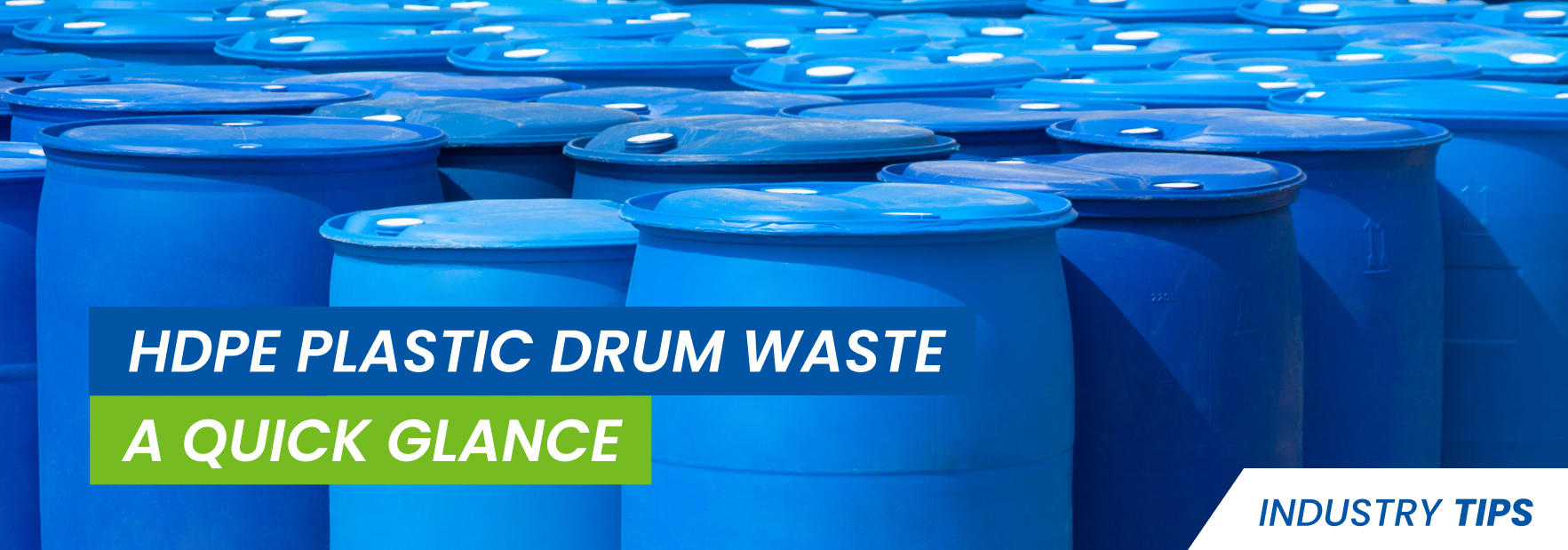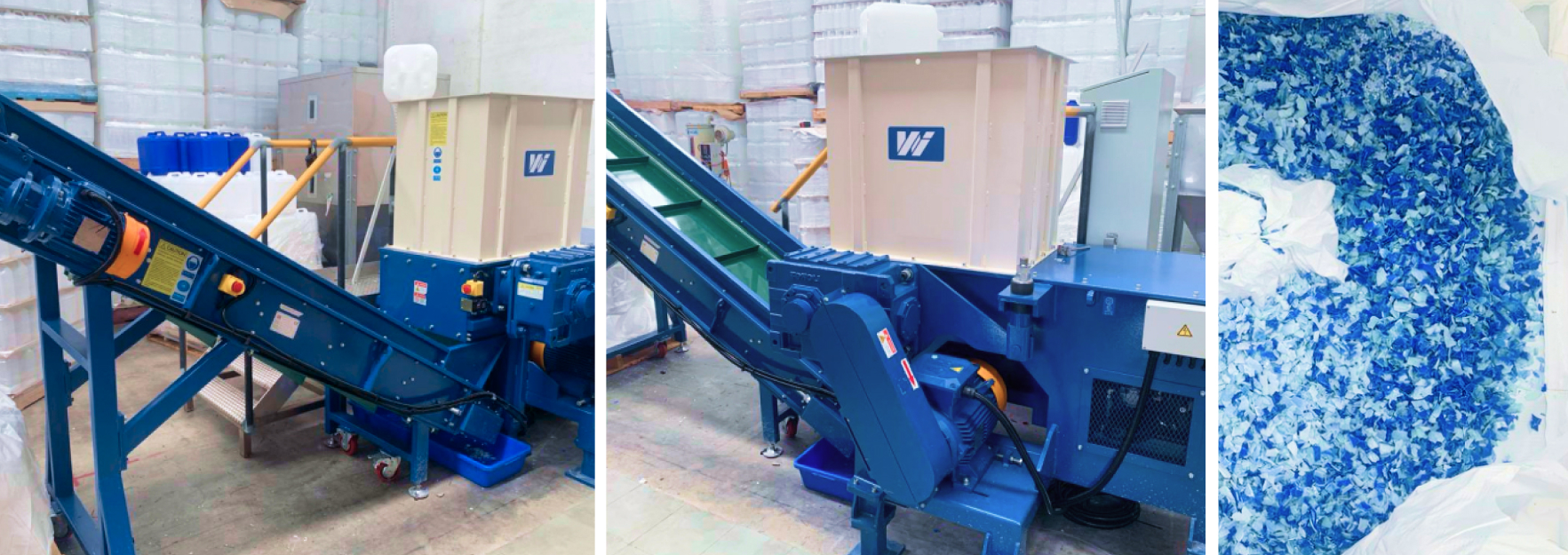
High-density polyethylene (HDPE) plastic drums and containers are widely used across Australia to store and transport chemicals, oils, and food products.
However, their extensive use poses a significant environmental challenge: managing the disposal and recycling of the HDPE plastic drum waste. Addressing this issue requires a thorough understanding of plastic drum waste, current disposal statistics, and effective recycling solutions, including mechanical methods such as shredding and granulating.
Key Facts About HDPE Plastic Drum Waste
- Annual Waste Generation: Australia produces approximately 50,000 tonnes of HDPE plastic drum waste each year. Unfortunately, less than 10% of this waste is recycled, with the majority ending up in landfills.
- Recycling Efforts: The Australian government is actively enhancing recycling efforts. Policies include banning mixed plastic waste exports since 1 July 2021, aiming for a 70% recycling or composting rate for plastic packaging by 2025, and targeting an 80% resource recovery rate by 2030.
- Mechanical Recycling: HDPE plastic is highly suitable for mechanical recycling, a key method for managing plastic waste.
Disposal Methods for HDPE Plastic Drum Waste
- Direct to Landfill: A large percentage of HDPE plastic drums are disposed of in MSW, directly to landfills or illegally dumped. This method contributes to environmental damage, wastes valuable materials, and occupies valuable landfill space.
- Collection and Drop-off Services: These services gather large quantities of waste for recycling. While useful, they can be costly and may have limited coverage in certain areas.
- Drummuster Scheme: This scheme recycles agricultural chemical containers through a structured drop-off system. It accepts cleaned, non-returnable containers from 1L to 205L used in agriculture. Containers must display the DrumMuster logo, with hazardous products required and non-hazardous optional. Containers without the logo are not accepted.
- Mechanical Recycling: Mechanical recycling processes for HDPE plastic waste involve physical activities such as collecting, picking, sorting, shredding, washing, extruding, and pelletising. These processes are typically conducted in recycling, industrial waste and manufacturing facilities.
- Advanced Recycling Technologies: Techniques such as purification, depolymerisation, and conversion (e.g., gas, pyrolysis, hydrothermal) complement mechanical recycling. These methods can produce food-grade recycled plastic and are poised to create new markets for recycled polymers and fuels in Australia.
Plastic Drum Shredding Systems
Plastic Drum Shredding Systems efficiently process HDPE plastic drum waste, converting them into smaller, manageable pieces. This streamlines the recycling process, boosts efficiency, and reduces costs, often resulting in a quick return on investment. The system supports a circular economy by minimising the need for virgin plastics, reducing landfill use, and lowering environmental impact through decreased pollution.
Key Components of Plastic Drum Shredding Systems
- Shredders: Heavy-duty machines that reduce plastic drums and containers into smaller fragments.
- Conveyors: Transport shredded material to subsequent processing stages.
- Granulators: Refine shredded plastic into granules or flakes.
- Sorting Equipment: Utilises magnet, metal detection, eddy current and air separation equipment to remove contaminants, sort or move particles through the system.
Plastic Drum Shredding: a Viable Solution
Waste Initiatives offers advanced plastic drum shredding systems designed to handle HDPE plastic waste efficiently. These systems streamline the recycling process, increase recycling rates, and enhance resource efficiency by making waste material more accessible for further processing.
Engineered Waste Solutions – Case Study
Waste Challenge: HDPE Purgings and Drums
Waste Goal: To divert HDPE waste from landfill
Cormack Holdings in QLD resolved their HDPE waste issue by using a WT2260 single shaft shredder to efficiently break down large plastic purgings and drums into flakes for recycling, improving operations and reducing landfill waste.
CLICK HERE to find out more.

Why Choose Waste Initiatives for your plastic drum shredding systems?
At Waste Initiatives, we are dedicated to providing our clients in Australia and New Zealand with the best waste management solutions available. As a trusted distributor of complete shredding systems, we bring you the expertise and support needed to integrate our equipment into your operations seamlessly.
Comprehensive Support and Service: From initial consultation and system installation to ongoing maintenance and support, Waste Initiatives offers end-to-end service. Our team of experts is here to ensure that you get the most out of your investment.
Engineered Solutions: We understand that every business has unique needs. Our team works closely with you to customise your shredding system to fit your specific requirements, ensuring optimal performance and efficiency.
Commitment to Innovation: As leaders in waste management solutions, we are committed to staying at the forefront of industry innovation. We continuously seek out and provide the latest technologies and systems to help our clients manage their waste more effectively and sustainably.
Conclusion
Managing HDPE plastic drum waste is a major environmental challenge in Australia. Current methods, such as drop-off and collection services, offer limited relief, especially for large-scale producers. Plastic Drum Shredding Systems are a viable solution, transforming waste into valuable, reusable resources. By incorporating advanced recycling technologies, we can more effectively manage HDPE waste, conserve resources, and advance sustainability.
For more information about our Plastic Shredding Systems or to discuss your waste management needs, please visit our website or download our Shredding Systems Brochure.
Contact Waste Initiatives today to learn more about how this advanced system can benefit your business.



